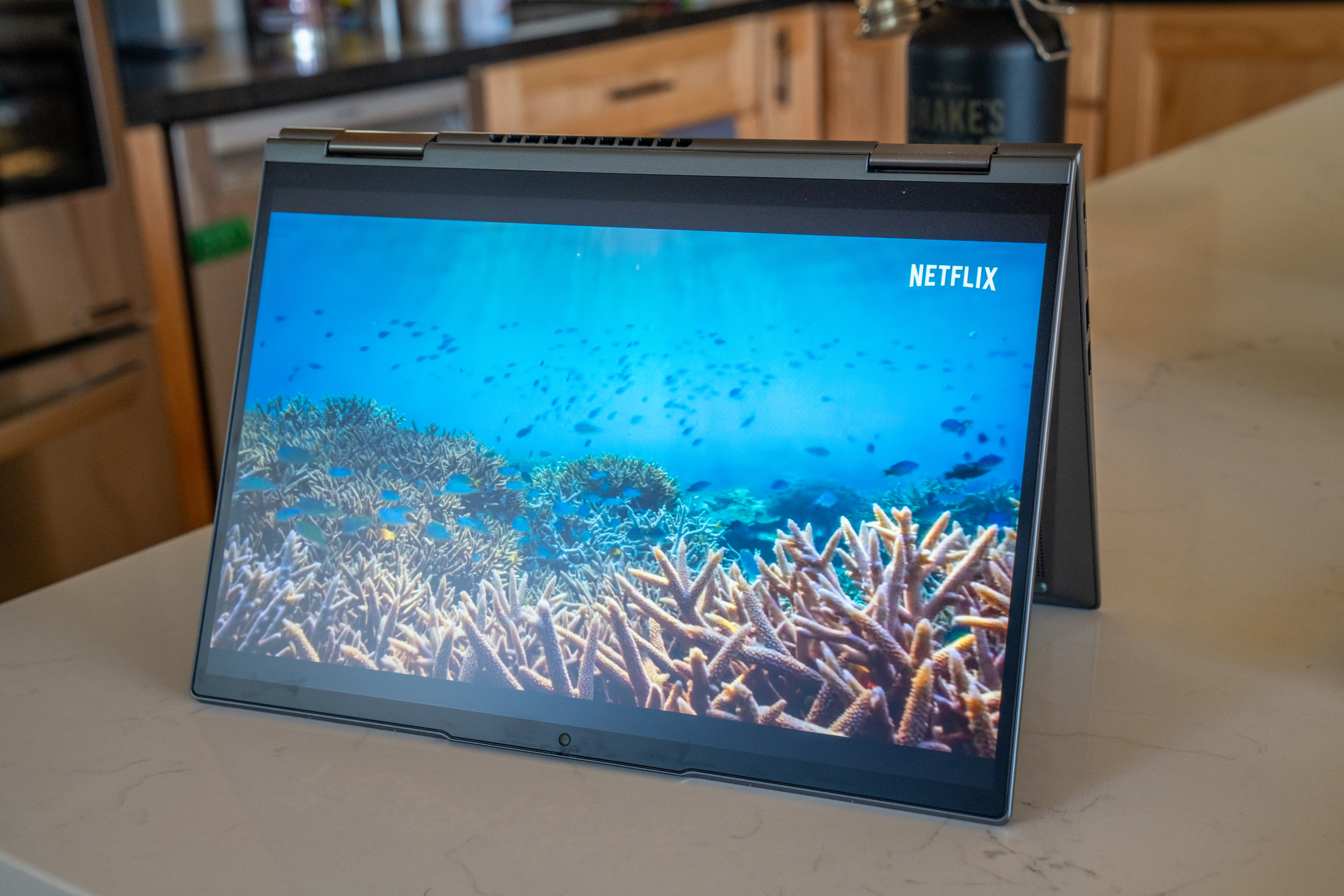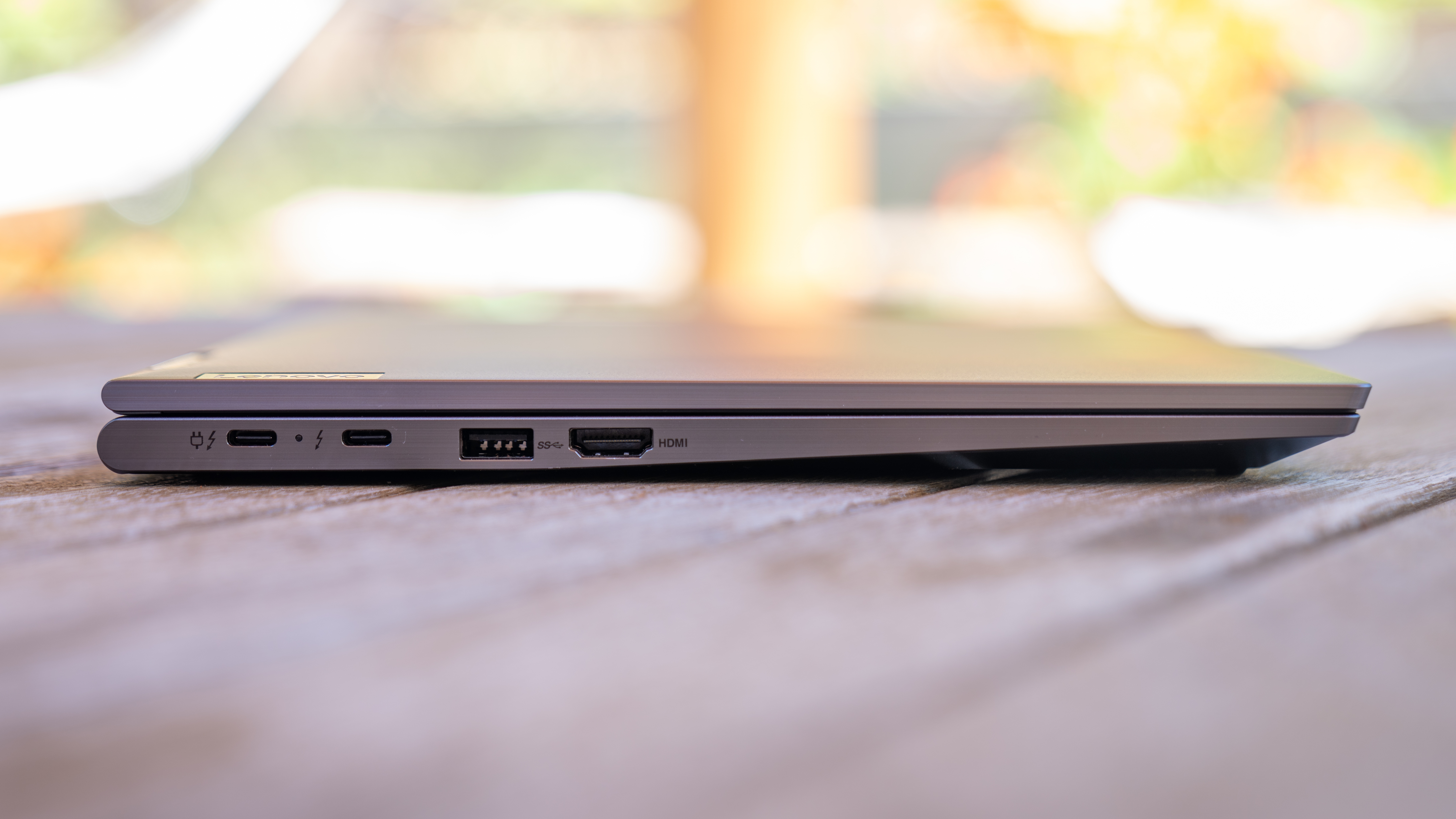Lenovo ThinkPad X1 Yoga Gen 8 review
The ThinkPad X1 Yoga Gen 8 is the latest iteration of the mashup between Lenovo’s business-focused Thinkpad line, and the consumer-focused Yoga. The basic business aesthetic is joined by a convertible design, offering a greater degree of flexibility (ha!) for folks who want it.
All told, this machine is near identical to Lenovo’s ThinkPad X1 Carbon Gen 11, for about $100 extra. I’m personally on the fence as to whether the 2-in-1 design is worth it, but if there’s room in your budget, this laptop earns a spot on the shortlist.
Lenovo ThinkPad X1 Yoga Gen 8 review: Price and configurations
The Lenovo ThinkPad X1 Yoga Gen 8 I’m checking out runs on an Intel Core i7-1355U CPU paired with 16GB of RAM. The single M.2 PCIe slot is occupied by a 512GB NVMe drive, and the PC runs Windows 11 Pro. This loadout will set you back $1,671.45, as configured, at time of writing.
The line starts at $1,448.99, with 512GB of storage, 16GB of RAM, and a Core i5 processor. The highest level configurations will double the RAM and storage and come equipped with Core-i7 processors, starting at $2,045.45 and climbing from there.
Lenovo ThinkPad X1 Yoga Gen 8 review: Design
The X1 Yoga Gen 8 doesn’t stray too far from the ThinkPad mold. At 3.1 pounds the aluminum chassis is relatively light and easy on the eyes, if a bit bland. It’s sturdy, resisting my attempts to twist or bend the body or display awkwardly. And the flexible hinge is both rigid and smooth, keeping the display locked in place while I type away, but also lifting open or sliding close with a single finger.

This is a work-focused machine, and the simple, accent-free design is appropriately bland — which is fine with me. The familiar ThinkPad touches will let the folks around you know you mean business, and I’ll always appreciate that glowing red led that dots the “i” on the lid, but I’m a little hung up on the “Yoga” aspect. A near identically equipped Lenovo ThinkPad X1 Carbon Gen 11 costs about $100 less (at time of writing), and is a little lighter (2.5 pounds, versus 3.1 pounds). When weighing the pros and cons of nigh $2,000 machines I suppose that’s not all that much, but given how often I’d use the 2-in-1 aspects of the machine versus, say, a really nice mouse, it’s enough to give me pause.
Lenovo ThinkPad X1 Yoga Gen 8 review: Display
The 14-inch, 1,920 by 1,200 pixel resolution IPS display is fit for purpose. The OLED-equipped competition arguably has it beat on boldness and brightness, but the Yoga Gen 8’s display is bright and colorful enough to get the job done, while saving on power and cost.
In our test, the display reproduced 98.4% of the sRGB spectrum (100% accuracy, or as close to that as possible, is ideal), and 69.7% of the DCI-P3 spectrum. Images and videos look accurate, if not especially vivid, and I wrote, read, and browsed for the full breadth of the machine’s extensive battery life without complaint. We measured an average of 362 nits of brightness across the display, great for reading and writing indoors and out. Direct sunlight, as ever, is less than ideal, but the display holds up in all but the most extreme conditions and awkward viewing angles.
Lenovo ThinkPad X1 Yoga Gen 8 review: Ports
There are a pair of USB-C ports on the left side of the Yoga Gen 8, joined by an HDMI port and a USB A 3.2 port. On the right, you’ll find another USB A 3.2 port, a 3.5mm audio jack, and a Kensington Security lock.

At the risk of sounding like a broken record I’ll reiterate that it’d be great to see the USB-C ports split across the machine, for a bit of versatility when charging the device. It’s a frustratingly infrequent design choice, but now that I’ve used and own a few machines with ports on either side, it’s something I always look for.
Lenovo ThinkPad X1 Yoga Gen 8 review: Keyboard, touchpad & stylus
Lenovo’s longstanding keyboard pedigree still holds true, even as their typing implements have evolved. The Yoga Gen 8’s chiclet-style keys are comfortably wide, taking up the full breadth of the available space so my large hands have room to meander. There’s a general amount of travel with every press, so I can type accurately and comfortably. And a fingerprint reader is integrated into the power button, for convenient biometric access if you prefer using your digits to your face.
The Yoga Gen 8 sports a stylus, handy for taking notes the old fashioned way. While Windows 11 does offer some stylus support natively, the (pleasant) lack of bloatware means you’ll need to do a bit of legwork to find apps and tools that’ll put that stylus to work. I’ve long since grown accustomed to tooling around in Photoshop and Lightroom with a mouse or touchpad so the stylus is a bit awkward for me, even if 2-in-1 design means I can get closer to my work than usual. But, as ever, your mileage may vary.
I’ve spoken at length about Lenovo’s signature red nub plenty of times over the years, and suffice to say I’m not a fan. There’s nothing objectively wrong with it, and it certainly had its place when touchpads were mediocre or non-existent, or pairing a mouse with your machine was more trouble than its worth. But those times have passed: Bluetooth is a thing, touchpads are better than ever, and the red nub and it’s requisite trio of buttons make for a touchpad that’s smaller than it needs to be. Don’t get me wrong: it’s small and unobtrusive, and smooth and responsive for those who do decide to use it. But it’s a solution to a problem that hasn’t existed for a long, long time. I’ll go ahead and risk the ire of nub fans: let’s finally be rid of it, and swap in a nice, larger touchpad.
Lenovo ThinkPad X1 Yoga Gen 8 review: Audio
The pair of Dolby Atmos-powered speakers sit on either side of the keyboard, firing up towards the user. While not spectacular, they’re perfectly in line with my expectations on a laptop this thin. Dialogue in videos and on conference calls is clear. The lack of bass is expected, and only partially ameliorated by futzing around with the Dolby Access equalizer. I ultimately didn’t mind. Audiophiles will find more nits to pick, but speakers get suitably loud without sounding distorted, and do the job well enough.
Lenovo ThinkPad X1 Yoga Gen 8 review: Performance
The Yoga Gen 8’s Intel Core i7-1355U CPU scored 8,648 on the GeekBench 5.5 Multicore benchmark. That’s a fair score, albeit lower than some recent, less expensive options: the $1,449 Dell XPS 13 Plus (2023) core 9,938, and the $1,199 Lenovo Slim Pro 7 scored 9,031.
The Yoga Gen 8 completed our Handbrake 1.6.1 benchmark test in 8 minutes and 41 seconds. The tests consists of using the video encoding tool Handbrake to transcode a 4K video clip down to 1080p. The Dell XPS 13 Plus completed the same test in 6 minutes and 31 seconds, while the Lenovo Slim Pro 7 took 6 minutes and 36 seconds.
Gaming performance is unsurprisingly non-existent, as the machine is limited to its Intel CPU’s integrated graphics. We saw an average of 20 frames per second in Civilization VI at 1080p and at the native 1,920 by 1,200 resolution; the machine’s work-centric focus strikes again. For my own needs, while I wouldn’t lean on this device to do my image editing work it handled Adobe’s cloud-centric Lightroom well enough. Similarly, browsing the web, wrangling spreadsheets, and hours of writing won’t tax the machine at all. It’s a tool meant to carry out a particular purpose — everything required by your standard office productivity suite — and if you stick close to that lane, you’ll be happy.
Lenovo ThinkPad X1 Yoga Gen 8 review: Battery life & heat
The Yoga Gen 8 lasted for 14 hours and 17 minutes on our automated battery test, which consists of setting the display’s brightness to 150 nits and browsing the web while on Wi-Fi until the battery dies.
That’s a great result — the Carbon Gen 11 lasted for 13 hours and 45 minutes — but real world use can be a bit more taxing. I averaged closer to between 10 and 10 and a half hours in my own usage, as I worked in processor intensive apps like Photoshop and Lightroom to make some use of the stylus and folding design, while streaming video and playing music. That’s still more than enough power to make it through a long working they and then some, before you need to reach for that USB-C cable.
Heat wasn’t really ever an issue during my time with the machine. I could feel warmth from the underside of the machine while using Lightroom, but it never reached concerning levels while sat in my lap. In our tests, it peaked at 102.9 degrees Fahrenheit, on the underside of the machine.
Lenovo ThinkPad X1 Yoga Gen 8 review: Webcam
The built-in 1080p supports Windows Hello, so you can log in with your face when you’d rather not log in with a finger. It’s also fine for videoconferencing; not as robust as we might come to expect from our smartphones in the era of the selfie and FaceTime, but still adequate with proper lighting. It’s also capable of a few advanced tricks, like blurring the background so you stand out, or adjusting the image with filters so your eyes appear to be looking at the camera. There’s also a privacy shutter, for that extra bit of piece of mind.
Lenovo ThinkPad X1 Yoga Gen 8 review: Software
There isn’t all that much by way of additional software here. Lenovo Commercial Advantage collects a lot of the sort of diagnostic and device info you’d find by poking around in Windows 11’s settings menus, and gathers it all in one place; handy if you need to reach out to customer service, or if you want a different venue to fire off system updates from.
Lenovo View offers tools to enhance the webcam experience, from changing the color temperature and brightness of the image, to blurring your display when someone approaches you or helping you improve your posture. The Dolby Access app is also included, offering audio presents and equalizers so you can tweak the audio to your liking.
Lenovo ThinkPad X1 Yoga Gen 8 review: Verdict
Lenovo’s ThinkPad X1 Yoga Gen 8 is built for business, sacrificing frills on the altar of productivity. It’s a little pricier than competitors that have it beat on performance, can’t handle games, and is a bit dull to look at, to boot. And that’s okay! That “ThinkPad” pedigree, while arguably mostly a branding exercise, provides a value that’s harder to measure than synthetic benchmarks and discrete GPUs. A simple design, bloat-free user experience, and the durable chassis are part of that premium that sets business-class hardware apart.
I’d argue it’s worth paying extra for that — mostly. The folding hinge is arguably useful to many, but I’ve also found the full tablet experience I get from Microsoft’s Surface lineup to be more my speed, and would lean towards the ThinkPad X1 Carbon Gen 11 instead.
For all the latest Technology News Click Here
For the latest news and updates, follow us on Google News.
